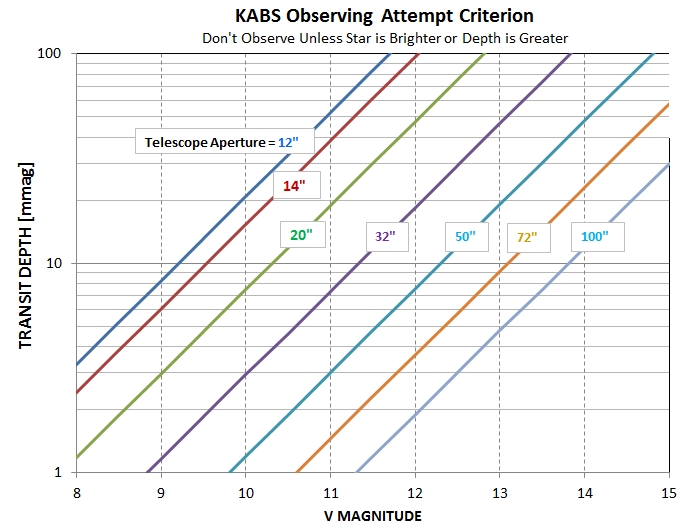Kepler Amateur Blue-Spike (KABS) Observations
Webmaster: Bruce Gary, 2014 Jul 29
This web site lists Kepler
candidates needing 2-color observations of
transit light curves for the purpose of
helping to distinguish between the
"exoplanet" interpretation and the "blended
eclipsing binary" interpretation for Kepler
transit candidates. These two
interpretations can be recognized due to the
fact that ingress and egress shapes differ
due to stellar limb darkening that causes a
small transiting object to block more red
light near 1st and 4th contacts compared to
the smaller effect by a large transiting
object (as first demonstrated by Tingley et
al, 2014, and described as a theoretical
possibility by Rosenblatt, 1971).
Differencing the g' and z' magnitudes, for
example, produces a "blue spike" just after
1st contact (and just before 4th contact)
that can be ~1 mmag. This web page lists
Kepler candidates that are most likely to
exhibit the "blue spike" effect if the
transiting object is an exoplanet (while
showing minimal effect if the transiting
object is a grazing star). Only advanced
amateurs with apertures of 12 inches or
greater should attempt such observations.
(Anyone who hasn't read this web page before
should begin by reading the Introduction
section, below.)
Recent Updates:
Jul 29: Uploaded a list of Kepler candidates needing 2-color
transit observations
Feasibility Chart:
 Figure 1. Guidance for assessing feasibility of
providing useful 2-color transit shape information, based
on the star's brightness, transit depth and telescope
aperture. The area above the trace is "feasible." For
example, a 14-inch telescope observing a star with V-mag = 9.5
can provide "useable" transit observations when transit depth
> 10 mmag. This assumes sufficient pre-ingress and
post-egress data are available, and the light curve quality is
good in other respects. (This graph will be revised as more
feasibility observations are obtained.)
Currently Active List:
Figure 1. Guidance for assessing feasibility of
providing useful 2-color transit shape information, based
on the star's brightness, transit depth and telescope
aperture. The area above the trace is "feasible." For
example, a 14-inch telescope observing a star with V-mag = 9.5
can provide "useable" transit observations when transit depth
> 10 mmag. This assumes sufficient pre-ingress and
post-egress data are available, and the light curve quality is
good in other respects. (This graph will be revised as more
feasibility observations are obtained.)
Currently Active List: (light curves
are at
KABS LCs)
 Figure 2. The "Currently Active List" above is for
Kepler candidates with small impact parameter, long period and
transit depth > 4 mmag.
Figure 2. The "Currently Active List" above is for
Kepler candidates with small impact parameter, long period and
transit depth > 4 mmag. An approximate correction for
BJD-JD has been applied, and all times are UT (i.e., JD).
List of Submitted Observations -
Individual LCs are at KABS LCs
[not supported yet]
ymdd K00410.01 P= 07.22
d Observer: Comments (this is a placeholder
line sincve no observations have been submitted yet)
KABS Observed Candidates & Blue-Spike Status
The table below summarizes KABS results (as of
2014.07.28).
[No table here yet]
The "Event" column can be either "tr" for full transit, "ing" for
ingress only, "egr" for egress only, "oot" for out-of-transit, and
"no sho" for no show.
The "D" column shows depth in mmag.
The "dt" column shows observed mid-transit time minus Kepler
ephemeris predicted transit time, in minutes.
The "L" column shows transit length (ingress to egress), in hours.
The "dt/se" column is self evident.
The "bands" column shows which two filters were used
The "color" column is the difference in magnitude after ingress or
before egress (short wavelength magnitude minus long wavelength
magnitude)
The "Notes" column has miscellaneous info. All "false positives"
should be disregarded.
______________________________________________________________________________________________________
Introduction
This observing project is "ambitious." In other words, it isn't
feasible for most advanced amateurs, and it may not even be
feasible for any observers. This is mostly due to the
need for large apertures, which few amateurs have. The purpose for
creating it is to find out, empirically, whether amateurs are
capable of contributing to the measurement of the "blue spike"
feature.
Submission Instructions
You may send a text file (JD and magnitude columns) to
Bruce Gary using the following e-mail address:

If you send an attached text file
I'll process it to produce a LC, and if it's good quality
I'll post it on another web page (KABS LCs)
[not
supported yet].
Sample LCs
Here are a couple examples of transit quality using typical
amateur hardware. The first one is for a 45 mmag deep transit
(probably a blended EB) using a 14-inch aperture telescope with g'
and i' filters. It's a good example of what we can expect from
modest size telescopes observing a single Kepler candidate with a
deep transit. The g'-i' magnitude plot exhibits a noise level of ~
1 mmag per 15 minute average.

Figure 3. This is an example of what a modest
aperture telescope can do with a bright Kepler candidate
for a single transit.
References
Tingley, B. et al, A & A, 2014, http://lanl.arxiv.org/abs/1405.5354
Rosenblatt, F., 1971, Icarus, 14, 71.
NASA Exoplanet Archive, Kepler 5465 List: http://exoplanetarchive.ipac.caltech.edu/cgi-bin/ExoTables/nph-exotbls?dataset=cumulative
Kepler mission home page: http://kepler.nasa.gov/
Exoplanet Observing for Amateurs (free book, PDF, or $2
eBook at Amazon.com): http://brucegary.net/book_EOA/x.htm
____________________________________________________________________
WebMaster: B. Gary. Nothing on this web page is copyrighted. This
site opened: July 29, 2014


